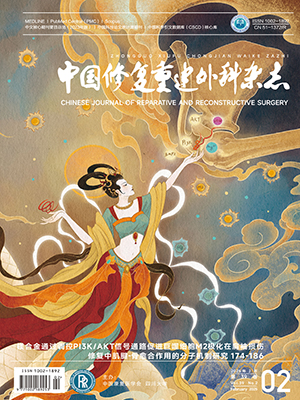Objective To investigate the morphological anatomical abnormal ities of high congenital dislocation of hip in adults and provide anatomical basis for the total hip arthroplasty (THA). Methods From May 1997 to July 2008, 49 patients (57 hi ps) with high congenital dislocation of hip (Hartofilakidis type III) were treated. There were 6 males and 43 females with an average age of 29.4 years old (18-56 years old). The locations were left in 24 hi ps and right in 33 hi ps. The morphological parameters (including femoral length, isthmus, height of femoral head center, neck-shaft angle, medial
head offset, anteversion angle, canal flare index, anteroposterior diameter of the true acetabulum, posterior thickness of the true acetabulum, depth of the true acetabulum) of suffering hips (dislocation group, n=57) were measured by preoperative X-ray, CT and intraoperative cl inical observation and were compared with those of contralateral hips (control group, n=41). The intraoperative situations of hip were observed. Results The height of dislocation was (45.41 ± 2.15) mm. The length difference of both lower extremities was (40.41 ± 2.02) mm. In dislocation group, isthmus was shortened; height of femoral head center, neck-shaft angle and medial head offset were decreased; and anteversion angle was increased. CT showed that the canal flare index was larger than 4.7, femoral shape was funnel-shaped according to Noble classification. Anteroposterior diameter of the true acetabulum became smaller, posterior thickness of the true acetabulum became thicker, and depth of the true acetabulum was shallower. There were statistically significant differences in the morphological parameters of femur and acetabulum between two groups (P lt; 0.05). The intraoperative measurements showed that the anteroposterior diameter of acetabulum was (32.98 ± 1.02) mm and the depth of acetabulum was (14.21 ± 0.56) mm. There was no statistically significant difference between intraoperative measurements and preoperative measurements (P gt; 0.05). The acetabulum was full of fat and fibrous tissues. Running of the sciatic nerve in 40 cases were changed and it ran upward and laterally. Conclusion When high congenital dislocation of the hip in adults is treated with THA, anatomical variation must be fully taken into account. The acetabulum is expanded toward posterosuperior, excessive reamed should be avoided to prevent femoral fractures, and appropriate or tailor-made prosthesis was selected.
Citation: LIN Hao,CAO Li,GONG Shiguo,A Sikaer,YANG Desheng,A Deli,PENG Libin.. CLINICAL ANATOMICAL STUDY ON HIGH CONGENITAL DISLOCATION OF HIP IN ADULTS. Chinese Journal of Reparative and Reconstructive Surgery, 2009, 23(9): 1075-1078. doi: Copy
Copyright © the editorial department of Chinese Journal of Reparative and Reconstructive Surgery of West China Medical Publisher. All rights reserved




